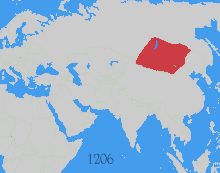Foundations[edit]
 The foundations of the Pax Mongolica lie in the Mongol Empire beginning withGenghis Khan in the early 13th century. In the process of conquering the various tribes in the region, Genghis Khan revolutionized the way Mongolian tribal society was structured.[4] After each new victory, more and more people were incorporated under Genghis Khan's rule, thus diversifying the societal balance of the tribe. In 1203, Genghis Khan, in an effort to strengthen his army, ordered a reform that reorganized his army's structure while breaking down the traditional clan- and kindred-based divisions that had previously fragmented the society and military. He arranged his army into arbans (inter-ethnic groups of ten), and the members of an arban were commanded to be loyal to one another regardless of ethnic origin.[5] Ten arbans made a zuun, or a company; ten zuuns made amyangan, or a battalion; and ten myangans formed a tumen, or an army of 10,000. This decimal system organization of Genghis Khan's strong military would prove very effective in conquering, by persuasion or force, the many tribes of the central Asian steppe, but it would also strengthen Mongol society as a whole.[6] By 1206 Genghis Khan's military expansion had unified the tribes of Mongolia, and in the same year he was elected and acclaimed as the leader of Mongolia.
The foundations of the Pax Mongolica lie in the Mongol Empire beginning withGenghis Khan in the early 13th century. In the process of conquering the various tribes in the region, Genghis Khan revolutionized the way Mongolian tribal society was structured.[4] After each new victory, more and more people were incorporated under Genghis Khan's rule, thus diversifying the societal balance of the tribe. In 1203, Genghis Khan, in an effort to strengthen his army, ordered a reform that reorganized his army's structure while breaking down the traditional clan- and kindred-based divisions that had previously fragmented the society and military. He arranged his army into arbans (inter-ethnic groups of ten), and the members of an arban were commanded to be loyal to one another regardless of ethnic origin.[5] Ten arbans made a zuun, or a company; ten zuuns made amyangan, or a battalion; and ten myangans formed a tumen, or an army of 10,000. This decimal system organization of Genghis Khan's strong military would prove very effective in conquering, by persuasion or force, the many tribes of the central Asian steppe, but it would also strengthen Mongol society as a whole.[6] By 1206 Genghis Khan's military expansion had unified the tribes of Mongolia, and in the same year he was elected and acclaimed as the leader of Mongolia.
Δεν υπάρχουν σχόλια:
Δημοσίευση σχολίου